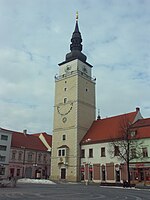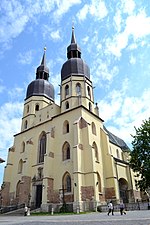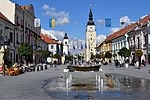Trnava
Cities and towns in SlovakiaPages including recorded pronunciationsPages with German IPAPages with Slovak IPATrnava ... and 1 more
Vague or ambiguous time from December 2020

Trnava (Slovak pronunciation: [ˈtr̩naʋa] , German: Tyrnau, German: [ˈtʏrnaʊ̯] ; Hungarian: Nagyszombat, also known by other alternative names) is a city in western Slovakia, 47 km (29 mi) to the northeast of Bratislava, on the Trnávka river. It is the capital of the Trnava Region and the Trnava District. It is the seat of a Roman Catholic archbishopric (1541–1820 and then again since 1977). The city has a historic center. Because of the many churches within its city walls, Trnava has often been called "Little Rome" (Slovak: Malý Rím, Latin: parva Roma), or more recently, the "Slovak Rome".
Excerpt from the Wikipedia article Trnava (License: CC BY-SA 3.0, Authors, Images).Trnava
Dolnopotočná, Trnava Vodáreň (Trnava)
Geographical coordinates (GPS) Address Nearby Places Show on map
Geographical coordinates (GPS)
| Latitude | Longitude |
|---|---|
| N 48.3775 ° | E 17.588333333333 ° |
Address
Dolnopotočná 6931/1
917 01 Trnava, Vodáreň (Trnava)
Region of Trnava, Slovakia
Open on Google Maps








